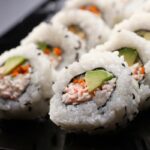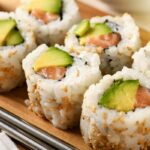You might think that maki roll is a type of sushi roll, but it actually is an old term that describes rolled sushi rice.
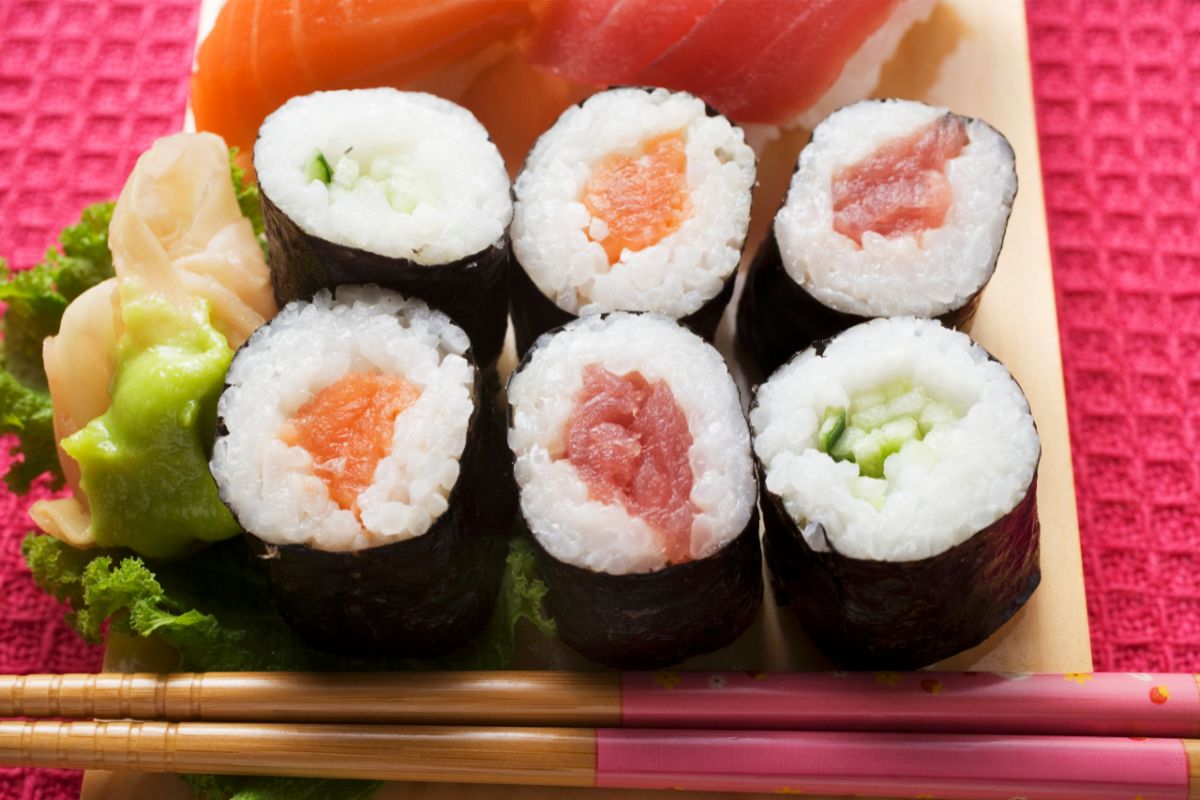
The word ‘maki’ is in reference to the ‘rolled rice with sushi’ part, while ‘sushi’ is in reference to the ‘rice which has been seasoned with vinegar’ part.
To make it even more fascinating, maki roll isn’t just sushi which uses nori (seaweed) sheets either. It can refer to sushi that uses soy paper, cucumber, omelet or even cabbage – to name a few.
If you are interested in understanding more about maki rolls, then read on!
What Is A Maki Roll?
A maki roll, which is also known as makizushi, is a traditional type of sushi from Japan. It contains a sour flavored rice which is created by adding vinegar. The rice covers ingredients such as veggies, fish or seafood due to it being rolled.
Traditionally it is then wrapped in a nori sheet, however other things can change the maki roll. Some of these are the techniques used to roll it as well as the ingredients and the size.
A maki roll may also be ‘inside out’. For example, the ingredients are in the middle, and then the nori sheet wraps around them. It is then covered in vinegar rice.
For all of these reasons, there are many types of maki rolls found across Japan. However, there are specific things that make a maki roll what it is.
How Does Maki Roll Differ From Regular Sushi?
It might be quite confusing to see how maki roll sushi is different from regular sushi. However, it is not as complex a thought as you might think.
Sushi in general can be any shape or size. In contrast, maki roll sushi can only be cylinder shaped and wrapped in vinegar sushi and nori. This makes this kind of sushi very specific. It does not matter how these ingredients are layered, however.
A maki roll can also have a number of ingredients inside the roll too such as raw and fresh seafood, veggies, fish, salmon roe and fruits.
A maki roll cylinder is cut into different thicknesses. Depending on the type of maki roll will change the thickness of the cut.
Are There Different Types Of Maki?
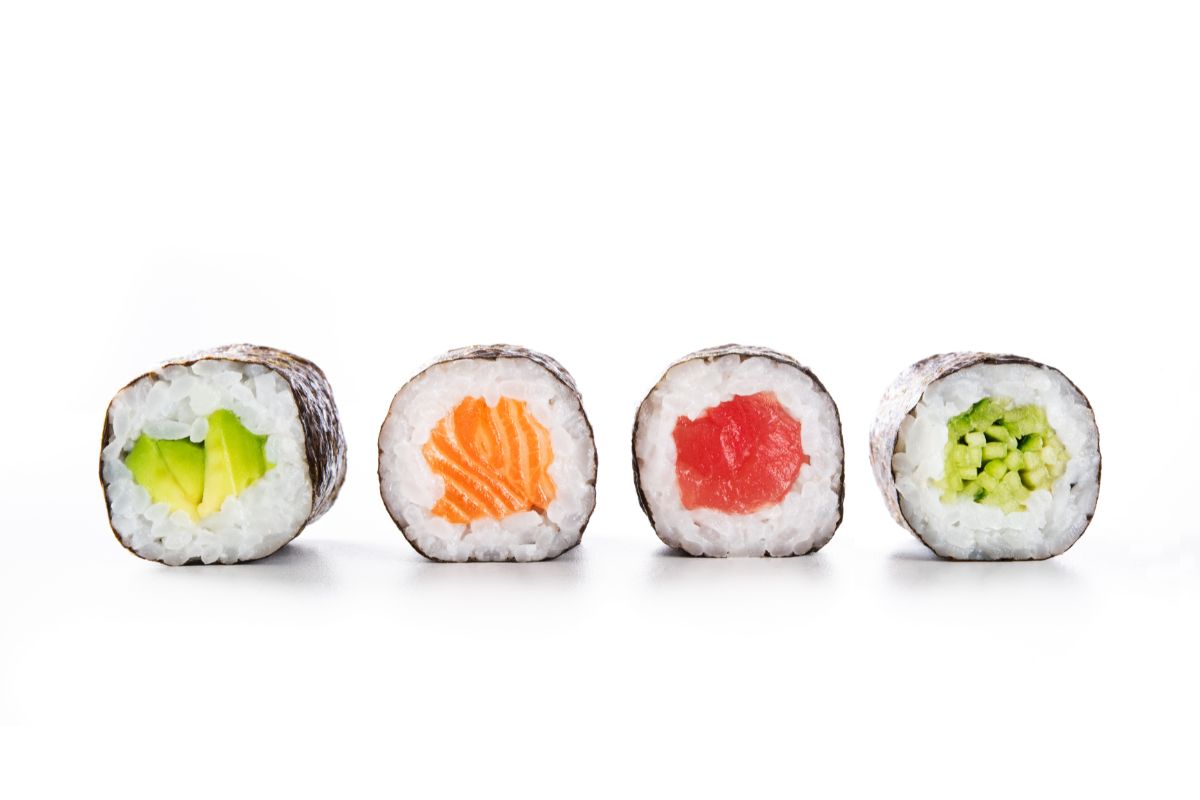
There are two main different categories when it comes to maki rolls: those with ingredients on the inside wrapped by nori, and those with rice wrapped around the nori.
There are also hand rolls which are very similar to tortilla wraps. It does include the vinegar rice and nori sheet too, however it is not folded or rolled. These are not traditional maki rolls, though they take elements from the maki roll – so we have included it.
As you can see, maki rolls generally come in different shapes, sizes and ingredients. It all depends on how the maki roll is cut, folded and what the rice ratio is to the filling.
Here are just a few popular examples:
Nori Outside
Chumaki
Chumaki tends to have up to three fillings and is wrapped in seaweed and nori. The diameter measures around 1.5 inches, and it is generally a medium thick size.
Futomaki
Out of all of the maki rolls, futomaki is both the biggest and thickest. For this reason it is also referred to as a ‘fat rolled sushi’.
In diameter it measures up to 2.5 inches. This is because it includes lots of ingredients such as fresh veggies, seafood (anago, unagi, or uni) and fish.
It is then completed by being wrapped in sour rice and a roasted thin sheet of nori.
Hosomaki
The word hosomaki translates to ‘thin rolls’ in Japanese. It tends to only have one ingredient inside which is often eel, tuna, cucumber or a pickled daikon.
Really thin nori sheets wrap around vinegared rice. Often a bamboo mat is used to help roll the thin nori sheet into shape.
Rice Outside
Uramaki
Also referred to as an ‘inside-out maki’, Uramaki has a filling which is wrapped by a roasted nori sheet, and then covered in vinegar drenched rice.
One of the ways the rice is ‘glued’ onto the nori is by using salmon roe (otherwise known as fish eggs).
Hand Rolls
Temaki
Temaki is a popular hand roll choice due to the way it is constructed. The nori sheet is folded in a way that resembles an ice cream cone. The filling is put inside. It is really easy to eat and is a fun way to enjoy a maki roll.
Are Maki Rolls Cooked Or Raw?
A maki roll can be made using both cooked and raw fish. However, it is more common for the Japanese to create maki rolls and sushi in general with raw fish.
It will be fresh fish too, which will add some delicious taste to the overall sushi. However, it is perfectly fine to use cooked fish if you are making your own. You might feel much safer doing so.
When using raw fish you will want to make sure that it stays contamination free. This can be difficult to do. If you are not careful you could suffer from food poisoning!
Are Maki Rolls Healthy To Eat?
Maki rolls tend to be very healthy due to the use of fish and fresh ingredients. More often than not a plethora of different fish and seafood fills a maki roll.
Fish include a high amount of omega-3 fatty acids which are essential for helping the body function correctly.
Also veggies are used in maki rolls. Vegetables are naturally high in nutrients and vitamins so it is a great way to get these things into your diet through eating maki rolls.
Is Maki The Same As Sashimi?
Sashimi is a highly skilled traditional Japanese dish that includes thinly cut slices of raw fish. They are cut in such a way that only those who can master the techniques can do it correctly. It often takes a few years to get it right.
Because sashimi does not include vinegar rice, veggies or nori, it is not considered to be a type of maki roll. A maki roll is just that – a roll. It is cylindrical and then cut to create the ‘mini’ rolls that are eaten.
It can also contain both raw and cooked fish too. Sashimi on the other hand can only be raw fish, and does not have the components of a maki roll.
Final Thoughts
While you might have heard of a maki roll, you might not know exactly what it is. It is actually very simple. It is a filling which is covered in vinegar rice and a nori sheet. The rolling method creates a cylinder shape. This is then cut again.
The thickness of each cut depends on the type of maki roll being made. The type of maki roll also depends on the ingredients inside the rice and nori sheet.
Sometimes a maki roll can also be filled with ingredients and then wrapped in a nori sheet with the rice on the outside. However, due to its shape and the ingredients used it is still classed as a maki roll.
- 16 Best Websites To Watch Japanese Movies With English Subtitles - May 11, 2023
- Is ZIPAIR The Best Airline For Traveling To Japan? - May 11, 2023
- Ryu Murakami Vs Haruki Murakami – Which One Should You Read? - May 11, 2023

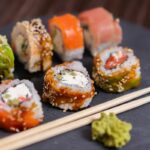
![What Sushi Has No Fish? [Vegetarian Sushi Explained] What Sushi Has No Fish? [Vegetarian Sushi Explained]](https://justaboutjapan.com/wp-content/uploads/2023/03/What-Sushi-Has-No-Fish-Vegetarian-Sushi-Explained-150x150.jpg)

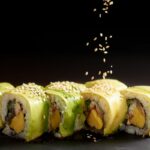
![How Many Types Of Sushi Are There? [Definitive Guide] How Many Types Of Sushi Are There? [Definitive Guide]](https://justaboutjapan.com/wp-content/uploads/2023/05/How-Many-Types-Of-Sushi-Are-There-Definitive-Guide-150x150.jpg)
